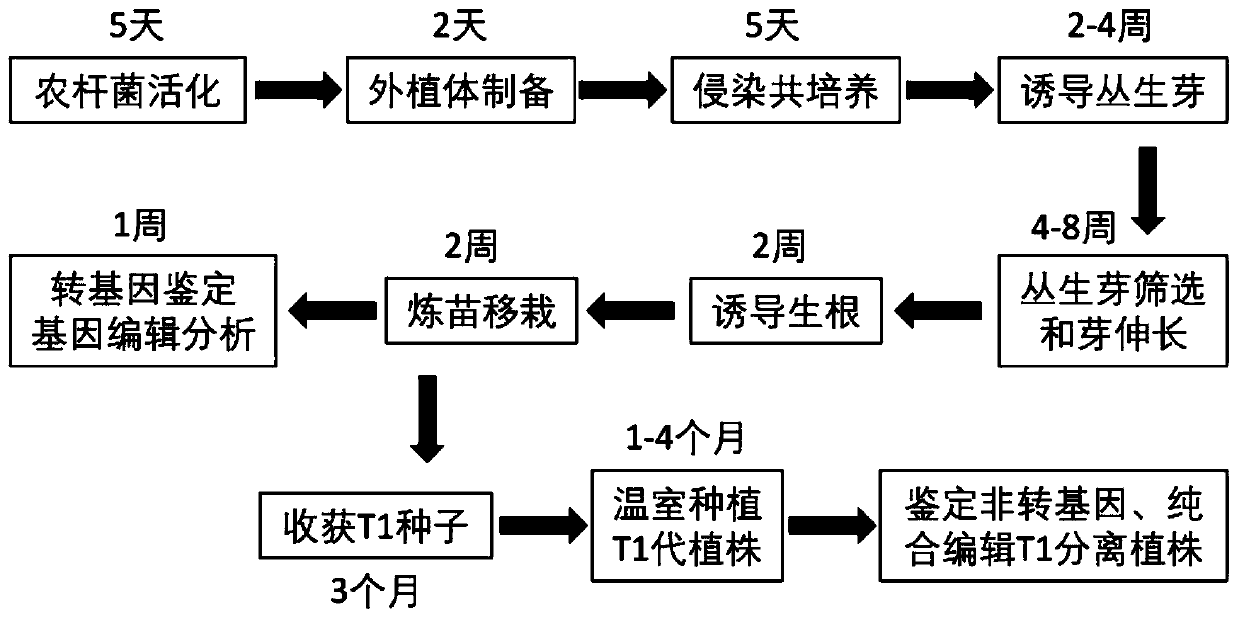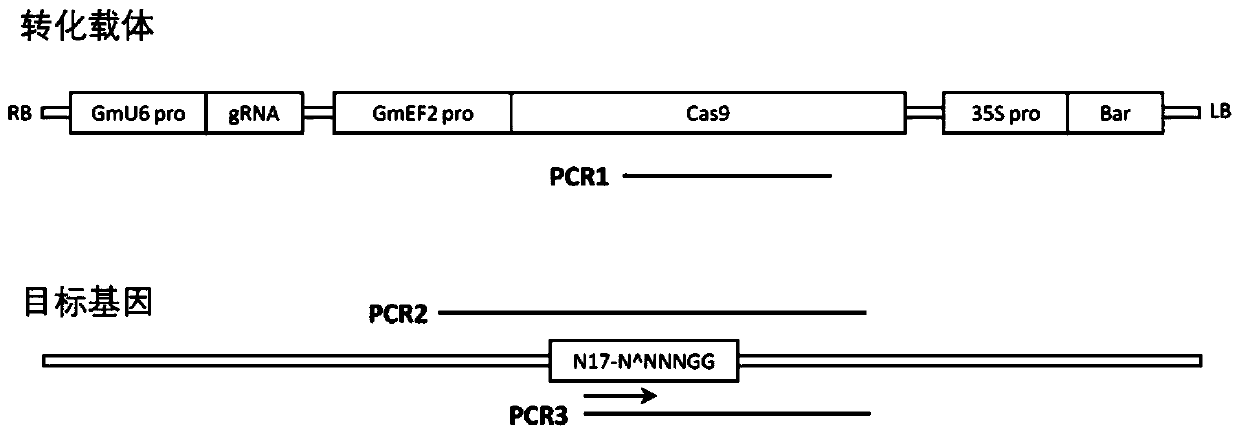Genetic transformation, gene editing and analysis methods of main soybean varieties
A method of genetic transformation and gene editing technology, which is applied in the field of genetic transformation, gene editing and analysis of main soybean varieties, and can solve the problems that no successful reports of soybean varieties have been seen, and the difficulty of transforming good soybean varieties.
- Summary
- Abstract
- Description
- Claims
- Application Information
AI Technical Summary
Problems solved by technology
Method used
Image
Examples
Embodiment 1
[0090] This example discloses the construction of the gene editing transformation vector KF57, which specifically includes the following steps:
[0091] (1) Cloning of soybean translation elongation factor gene GmEF2 promoter: Agrobacterium transformation vector for gene editing is based on pCambia3301 backbone, using eukaryotic cells encoding optimized Streptococcus pyogenes (Streptococcus pyogenes) Cas9 endonuclease and single The guide RNA (sgRNA) was expressed with the same carrier to realize the targeted cut-off of the target gene locus, and the transformed plants were screened using the Barnase gene expression of glufosinate-resistant herbicide (Glufosinate, phosphinothricin). The soybean Williams82 genome Glycine max Wm82.a2.v1 (phytozome.jgi.doe.gov) collected by the US Department of Energy contains multiple high-level constitutively expressed translation elongation factor genes including Glyma.05G089000.1, and its promoter is suitable for High-level expression of the ...
Embodiment 2
[0095] Example 2 Genetic Transformation of Kenbao Xiaoliudou No. 1
[0096] Gene editing can only be achieved by transforming the gene editing vector into cells for expression. In order to edit the Fad2 gene of Kenfeng’s self-owned excellent variety Kenbao Xiaoliudou No. 1, the Agrobacterium-mediated method was used to expand and germinate Kenbao Xiaoliudou No. 1. The seeds are explants, and the gene editing vector KF57 is transformed into soybean cells for knockout editing of the GmFad2-1A and GmFad2-1B genes. The specific operation process is as follows:
[0097] (1) Preparation of explants: Select Kenbao Xiaolidou No. 1 plump seeds with a smooth surface and no scars, put them in a petri dish and put them in a desiccator, add 96 ml of 10% sodium hypochlorite and 4 ml of concentrated hydrochloric acid to generate chlorine gas, and airtightly sterilize Seeds about 16 hours. Open the cover of the sterilized seeds in the ultra-clean bench and blow off the chlorine gas, add ster...
Embodiment 3
[0104] Embodiment 3 Genetic Transformation of Longken 314
[0105] Longken 314 is another Kenfeng self-owned fine variety that can be transformed by Agrobacterium-mediated transformation. Similarly, the transformation of KF57 can realize the knockout and editing of GmFad2-1A and GmFad2-1B genes, and obtain high oleic acid traits. The transformation process mediated by Agrobacterium is similar to that of Kenbao Xiaoliudou No. 1 mentioned above. Glufosinate at different concentrations of 4, 8, 12, 16, 20, and 30 mg / L was tested for screening, and it was found that Longken 314 Agrobacterium infection was suitable Concentration and the appropriate concentration of transforming screening agent are all slightly lower, and the two concentrations are too high to cause browning and death of explants and cluster buds respectively. 20mg / L glufosinate was used to screen the induction and elongation of clustered shoots, and 2 healthy plants were obtained from the transformation of 100 expl...
PUM
 Login to View More
Login to View More Abstract
Description
Claims
Application Information
 Login to View More
Login to View More - R&D
- Intellectual Property
- Life Sciences
- Materials
- Tech Scout
- Unparalleled Data Quality
- Higher Quality Content
- 60% Fewer Hallucinations
Browse by: Latest US Patents, China's latest patents, Technical Efficacy Thesaurus, Application Domain, Technology Topic, Popular Technical Reports.
© 2025 PatSnap. All rights reserved.Legal|Privacy policy|Modern Slavery Act Transparency Statement|Sitemap|About US| Contact US: help@patsnap.com



